Isolation Operative Dentistry Important Notes
1. Components Of Rubber Dam
- Rubber Dam Sheet
- Rubber dam clamp/ retainer
- Rubber dam frame
- Rubber dam punch
- Rubber dam retainer force
- Dental floss
- Template
Isolation Operative Dentistry Long Essays
Question 1. Enumerate various methods of Isolation. Describe in detail about rubber dam.
Answer:
Methods Of Isolation:
- Isolation Direct Method
- Rubber dam Cotton rolls
- Gauze piece Absorbent
- wafers Suction devices
- Gingival retraction cord
- Isolation Indirect Method
- Local anesthesia Drugs
- Anti sialogogues
- Anti-anxiety
- Muscle relaxants
Rubber Dam – By Dr. S.C. Barnum
Isolation Purpose:
- Control of moisture
- Retraction
- Protects soft tissues
- Improves quality of treatment
Isolation Contraindications:
- Asthmatic patients
- Allergy to latex
- Mouth breathers
- Extremely malpositioned tooth
- Third molar
Isolation Components:
1. Rubber Dam Sheet:
- Square sheets
- Size – 5″x 5” or 6″ x 6″
Isolation Thickness:
- Thin – 0.006″
- Medium – 0.008″
- Heavy -0.010″
- Extra heavy- 0.012″
- Special heavy – 0.014″
Isolation Color:
- Green/blue
- The dull side faces the operator
2. Rubber Dam Clamps/Retainers:
To secure the dam to the teeth
Rubber Dam Clamps Parts:
- 2 jaws
- Bow – connecting jaws
- 4 prongs – 2 on each jaw
Read And Learn More: Operative Dentistry Short And Long Essay Question And Answers
- Rests on line angle
Rubber Dam Clamps Types:
- Winged or wingless retainer
- Large, small, universal
3. Rubber Dam Retainer Forceps:
- Hold the retainer
- Facilitates its placement and removal
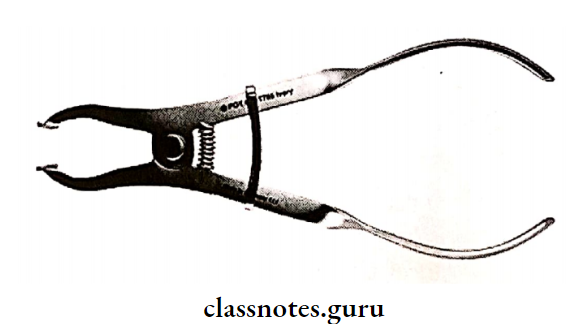
4. Rubber Dam Frame:
- U shaped frame
- Types – metal or plastic
- Has minute projections on its outer surface to secure the dam
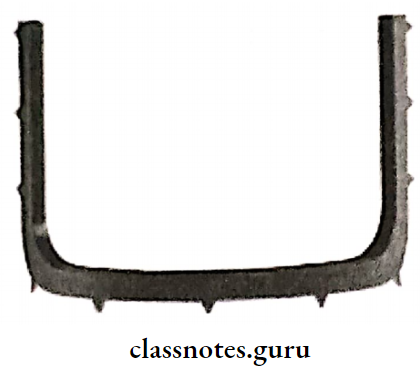
5. Rubber Dam Punch:
- For making holes in the dam
- Depending on the applied tooth, the sizes of the holes vary
6. Rubber Dam Template:
- Used to transfer the markings to the sheet
7. Dental Floss:
- To prevent accidental aspiration of the clamp
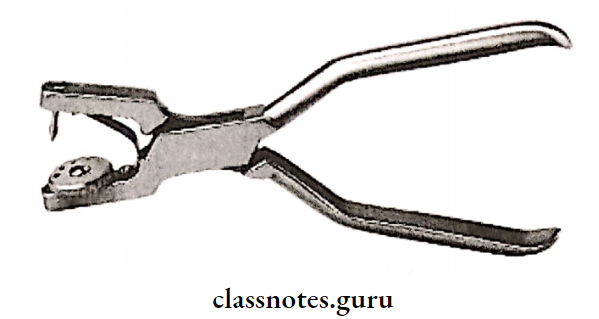
Rubber Dam Clamps Placement:
Comfortable position of the patient
↓
Selecting the appropriate clamp and sheet
↓
Punching a hole in the sheet
↓
Applying lubricant
↓
Holding clamp through forceps
↓
Placement of rubber dam
- The clamp is placed first and then the sheet is passed over it
- Placement of sheet and then securing it with clamp
- Both are placed together
Rubber Dam Clamps Removal:
Removal of clamp
↓
Stretching of sheet
↓
Cut all interseptal rubbers
↓
Remove the remaining
Question 2. Discuss the importance of isolation and various methodds used to achieve the same.
Answer:
Importance Of Isolation:
- Isolation helps for following
1. Moisture Control
- It refers to excluding sulcular fluid, saliva, and gingival bleeding from the operating field
2. Retraction And Access
- It provides maximal exposure of the operating site
3. Harm Prevention
- Prevents harm to the patient during the operation
- Small instruments and restorative debris can be aspirated or swallowed
- Provides patient comfort and operator efficiency
Isolation Direct Method:
1. Cotton Rolls:
- Moisture absorbent
- Provide minimal retraction
Isolation Types:
- Manual and prefabrication
- Stabilized by cotton roll holder
Site Of Placement:
- Maxillary anteriors – Either side of labial frenum
- Mandibular anterior
- Lingual sulcus
- On either side of labial frenum
- Maxillary posterior – Adjacent vestibules
- Mandibular posterior
- Buccally – vestibule
- Between tongue and teeth
- Moistened it before removal to avoid tearing off of gingiva
2. Gauze Pieces:
- Size – 2″ x 2″
Gauze Uses:
- To isolate larger areas
- As throat screens
Gauze Advantages:
- Better tolerated
- More acceptable
- Less adhesion to dry tissues
3. Absorbent Wafers:
- Made of cellulose
- Covers parotid ducts
4. Evacuators:
Evacuators Type:
- High vacuum
- Low vacuum
- High vacuum
- Removes debris from the working site
- Removal of toxic material
- Decreases treatment time
- Low Volume [Saliva ejectors)
- Used along with operative procedures
Types:
- Disposable plastic tips
- Autoclavable metallic tips
5. Gingival Retraction Cord:
- Inserted into gingival sulcus
- Retracts gingiva
Gingival Retraction Cord Types:
- Braided and non-braided
- Plain and impregnated
Gingival Retraction Cord Effects:
- Improved accessibility and visibility
- Protects gingival from abrasion
- Restricts placement of restoration into sulcus
- Everts gingival tissue
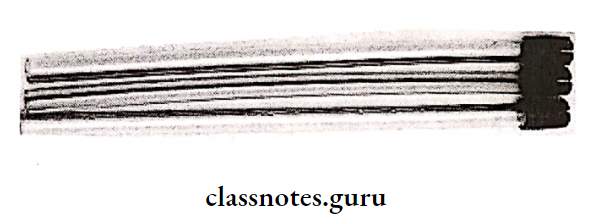
Indirect Method Of Isolation:
- It includes
1. Anaesthetic agents
2. Antisialogogues
- Chemical agent is administered orally 1-2 hours prior to the procedure
Indirect Method Of Isolation Effect:
- Causes temporary dry mouth by acting on sympathetic nervous system
Indirect Method Of Isolation Drug Of Choice:
- Atropine 0.1-1 mg
Indirect Method Of Isolation Contraindicated:
- Nursing mothers
- Patients with glaucoma
Indirect Method Of Isolation Advantage:
- Useful in hypersalivation
Indirect Method Of Isolation Disadvantages:
- Tachycardia
- Dilatation of pupils
- Urinary retention
- Sweat glands inhibition.
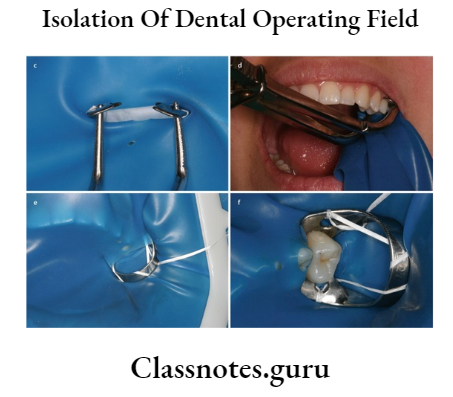
Isolation Operative Dentistry Short Essays
Question 1. Gingival Retraction/ Gingival tissue management.
Answer:
Gingival Retraction:
Gingival Retraction Methods:
1. Physicomechanical:
- Rubber Dam
- Heavy, extra heavy, and special heavy sheets provide adequate mechanical displacement of gingival tissue
- Wooden Wedges – Used interdentally
- Gingival Retraction Cords
- Displaces gingival laterally and apically
Gingival Retraction Placement:
- Anesthetize the area
- Select appropriate cord
- Pack the cord with cord tucking instrument, around the tooth
- Place it for 5 minutes
- Remove the cord after moistening it to avoid gingival abrasion
- Rolled Cotton Twills
- Laterally displaces gingival
- Combined with ZOE
- Rolled Cotton Twills
2. Chemical Means:
Chemical Used:
- Trichloroacetic acid
- Sulfuric acid
Advantage:
- Hemostatic
Disadvantage:
- Caustic
- Irritant
3. Chemico Mechanical Method:
Chemical Used:
- Vasoconstrictors – Epinephrine
- Astringents – Tannic acid
- Tissue coagulant – Silver nitrate
4. Rotary Curettage (Gingettage):
- Removes a minimal amount of gingival epithelium with the help of a high-speed handpiece and bur.
5. Electrosurgical Method:
- Alternating electric current energy is used at a high frequency
Actions:
- Cutting
- Coagulation
- Fulguration
- Desiccation
Question 2. Advantages of Rubber Dam.
Answer:
Advantages Of Rubber Dam:
- Maximizes access and visibility
- Protection of soft tissues
- Provides clean and dry field
- Avoids contamination
- Prevents aspiration of foreign bodies
- Improves efficiency
- Improves properties of dental material
- Protection of patient and dentist
Isolation Operative Dentistry Short Answers
Question 1. Gingival retraction cord.
Answer:
Gingival Retraction Cord:
- Inserted into the gingival sulcus
- Retracts gingiva
Gingival Retraction Cord Types:
- Braided and non-braided
- Plain and impregnated
Gingival Retraction Cord Effects:
- Improved accessibility and visibility
- Protects gingival from abrasion
- Restricts placement of restoration into the sulcus
- Everts gingival tissue

Question 2. Affected and infected Dentin.
Answer:
Affected And Infected Dentin:
1. Infected Dentin
- Irreversible denatured collagen
- Infiltrated with bacteria
- Notremineralizable
- Should be removed
- Darker
- Softer
- Lacks sensation
- Indistinct cross bands
- Stained With:
- 0. 2% propylene glycol
- 10% acid red solution
- 0. 5% basic Fuschia
2. Affected Dentin
- Reversible denatured collagen
- Not infiltrated
- Remineralize
- Left behind while the cavity
- preparation
- Lighter
- Harder
- It is sensitive
- Distinct cross bands
- Cannot be stained with any solution
Isolation Operative Dentistry Viva Voce
- Thinner rubber dam can pass through contacts easily
- A thicker rubber dam is more effective in retracting tissues and more resistant to tearing
- The jaws of the retainer should not extend beyond the mesial and distal line angles of the tooth
- The bow of the retainer should be tied with dental floss
- The tip of the saliva ejector must be smooth and of non-irritating material
- Gingival cord placement should not harm gingival tissue
- Atropine used for isolation is contraindicated in nursing mothers and patients with glaucoma
